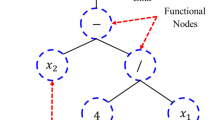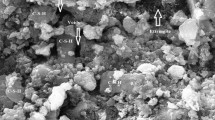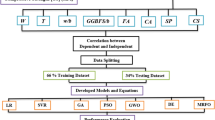Abstract
The advantage of new data mining-based solutions, and more recently, optimization algorithms (i.e., basically swarm-based solutions) have enhanced traditional models of engineering structural analysis. This paper investigates social behavior of Grey Wolf Optimization (GWO) in improving the neural assessment of friction capacity (fs) of concrete driven pile systems. Besides, the genetic programming (GP) algorithm was also proposed to have comparison with the proposed GWO prediction outputs. To achieve this goal, four fs influential factors of pile length (m), pile diameter (cm), effective vertical stress (Sv), and undrained shear strength (Su) are considered for preparing the required dataset. A swarm size-based sensitivity analysis is then carried out to use the best-fitted structures (i.e., more convergency in the final output) of each ensemble. The results of the best prediction network from both above-mentioned sensitivity analyses were compared. The results show that both GWO and GP models presented excellent performance. The findings of neural networks varied based on the number of neurons in a single hidden layer and of course the level of its complexity. Based on R2 and RMSE, values of (0.9537 and 9.372) and (0.8963 and 7.045) are determined, for the training and testing datasets of MLP-based solution, respectively. On the contrary, for the GP and GWO-MLP proposed predictive models, the R2 of (0.9783 and 0.982) and (0.913 and 0.892) were found for the training and testing datasets. This proves the better performance of GWO when combined with MLP in predicting engineering solutions comparing to conventional MLP or GP-based combinations.




















Similar content being viewed by others
References
Moayedi H, Raftari M, Sharifi A, Jusoh WAW, Rashid ASA (2019) Optimization of ANFIS with GA and PSO estimating α ratio in driven piles. Eng Comput 35:1–12
Moayedi H, Armaghani DJ (2017) Optimizing an ANN model with ICA for estimating bearing capacity of driven pile in cohesionless soil. Eng Comput 34:347–356
Liu L, Moayedi H, Rashid ASA, Rahman SSA, Nguyen H (2019) Optimizing an ANN model with genetic algorithm (GA) predicting load-settlement behaviours of eco-friendly raft-pile foundation (ERP) system. Eng Comput 36:1–13
Alkroosh I, Nikraz H (2012) Predicting axial capacity of driven piles in cohesive soils using intelligent computing. Eng Appl Artif Intell 25:618–627
Randolph MF (2003) Science and empiricism in pile foundation design. Géotechnique 53:847–874
Coduto R (2001) Foundation design principles and practices. Prentice Hall, Englewood Cliffs
Baker VA, Thomsen NA, Nardi CR, Talbot MJ (1984) Pile foundation design using pile driving analyzer. Analysis and Design of Pile Foundations, San Francisco
Tomlinson M, Woodward J (2008) Pile design and construction practice, 5th edn. Taylor and Francis Group, New York
Nazir R, Moayedi H, Subramaniam P, Ghareh S (2017) Ground improvement using SPVD and RPE. Arab J Geosci 10:21
Moayedi H, Huat BBK, Ali TAM, Asadi A, Moayedi F, Mokhberi M (2011) Preventing landslides in times of rainfall: case study and FEM analyses. Disaster Prev Manag 20:115–124
Gao W, Karbasi M, Derakhsh AM, Jalili A (2019) Development of a novel soft-computing framework for the simulation aims: a case study. Eng Comput 35:315–322
Gao W, Raftari M, Rashid ASA, Mu’azu MA, Jusoh WAW (2019) A predictive model based on an optimized ANN combined with ICA for predicting the stability of slopes. Eng Comput 2019:1–20
García-Balboa JL, Alba-Fernández MV, Ariza-López FJ, Rodríguez-Avi J (2018) Analysis of thematic similarity using confusion matrices. ISPRS Int J Geoinform 7:233
Samui P (2008) Prediction of friction capacity of driven piles in clay using the support vector machine. Can Geotech J 45:288–295
Schneider JA, Xu XT, Lehane BM (2008) Database assessment of CPT-based design methods for axial capacity of driven piles in siliceous sands. J Geotech Geoenviron Eng 134:1227–1244
Xia T, Wang W (2009) Study on evaluating methods for time-dependent ultimate bearing capacity of single driven pile. IEEE Computer Soc, Los Alamitos
Tran KT, McVay M, Herrera R, Lai P (2011) A new method for estimating driven pile static skin friction with instrumentation at the top and bottom of the pile. Soil Dyn Earthq Eng 31:1285–1295
Samui P (2011) Multivariate adaptive regression spline applied to friction capacity of driven piles in clay. Geomech Eng 3:285–290
Mosallanezhad M, Moayedi H (2017) Developing hybrid artificial neural network model for predicting uplift resistance of screw piles. Arab J Geosci 10:10
Samui P (2012) Determination of ultimate capacity of driven piles in cohesionless soil: a multivariate adaptive regression spline approach. Int J Numer Anal Methods Geomech 36:1434–1439
Moayedi H, Hayati S (2018) Artificial intelligence design charts for predicting friction capacity of driven pile in clay. Neural Comput Appl 31 (in press)
Gao W, Wang W, Dimitrov D, Wang Y (2018) Nano properties analysis via fourth multiplicative ABC indicator calculating. Arab J Chem 11:793–801
Nazir R, Moayedi H, Subramaniam P, Gue SS (2018) Application and design of transition piled embankment with surcharged prefabricated vertical drain intersection over soft ground. Arab J Sci Eng 43:1573–1582
Gao W, Wu H, Siddiqui MK, Baig AQ (2018) Study of biological networks using graph theory. Saudi J Biol Sci 25:1212–1219
Bui DT, Moayedi H, Gör M, Jaafari A, Foong LK (2019) Predicting slope stability failure through machine learning paradigms. ISPRS Int J Geoinform 8:395
Gao W, Guirao JLG, Basavanagoud B, Wu J (2018) Partial multi-dividing ontology learning algorithm. Inf Sci 467:35–58
Moayedi H, Tien Bui D, Gör M, Pradhan B, Jaafari A (2019) The feasibility of three prediction techniques of the artificial neural network, adaptive neuro-fuzzy inference system, and hybrid particle swarm optimization for assessing the safety factor of cohesive slopes. ISPRS Int J Geoinform 8:391
Mirjalili S, Mirjalili SM, Lewis A (2014) Grey wolf optimizer. Adv Eng Softw 69:46–61
Bozorg-Haddad O (2018) Advanced optimization by nature-inspired algorithms. Springer, Berlin
Muro C, Escobedo R, Spector L, Coppinger R (2011) Wolf-pack (Canis lupus) hunting strategies emerge from simple rules in computational simulations. Behav Process 88:192–197
Dehghani M, Riahi-Madvar H, Hooshyaripor F, Mosavi A, Shamshirband S, Zavadskas EK, Chau K-w (2019) Prediction of hydropower generation using grey wolf optimization adaptive neuro-fuzzy inference system. Energies 12:289
Koza JR (1994) Genetic programming as a means for programming computers by natural selection. Stat Comput 4:87–112
Rezania M, Javadi AA (2007) A new genetic programming model for predicting settlement of shallow foundations. Can Geotech J 44:1462–1473
Fatehnia M, Amirinia G (2018) A review of genetic programming and artificial neural network applications in pile foundations. Int J Geoeng 9:20
Obiedat R, Alkasassbeh M, Faris H, Harfoushi O (2013) Customer churn prediction using a hybrid genetic programming approach. Sci Res Essays 8:1289–1295
Cramer NL (1985) A representation for the adaptive generation of simple sequential programs. In: Proceedings of the first international conference on genetic algorithms
Baziar MH, Azizkandi AS (2013) Evaluation of lateral spreading utilizing artificial neural network and genetic programming. Int J Civ Eng 11:100–111
Pandey DS, Pan I, Das S, Leahy JJ, Kwapinski W (2015) Multi-gene genetic programming based predictive models for municipal solid waste gasification in a fluidized bed gasifier. Bioresour Technol 179:524–533
Zhai S, Mao J, Liu H (2017) Average velocity of debris flow forecast based on genetic programming combined with rough set theory. In: DEStech transactions on engineering and technology research
Goh ATC (1996) Pile driving records reanalyzed using neural networks. J Geotech Eng ASCE 122:492–495
Moayedi H, Mosallanezhad M (2017) Physico-chemical and shrinkage properties of highly organic soil treated with non-traditional additives. Geotech Geol Eng 35:1409–1419
Moayedi H, Armaghani DJ (2018) Optimizing an ANN model with ICA for estimating bearing capacity of driven pile in cohesionless soil. Eng Comput 34:347–356
Vakili AH, Bin Selamat MR, Mohajeri P, Moayedi H (2018) A critical review on filter design criteria for dispersive base soils. Geotech Geol Eng 36:1933–1951
Moayedi H, Hayati S (2018) Modelling and optimization of ultimate bearing capacity of strip footing near a slope by soft computing methods. Appl Soft Comput 66:208–219
Asadi A, Moayedi H, Huat BBK, Boroujeni FZ, Parsaie A, Sojoudi S (2011) Prediction of zeta potential for tropical peat in the presence of different cations using artificial neural networks. Int J Electrochem Sci 6:1146–1158
Asadi A, Moayedi H, Huat BBK, Parsaie A, Taha MR (2011) Artificial neural networks approach for electrochemical resistivity of highly organic soil. Int J Electrochem Sci 6:1135–1145
Raftari M, Rashid ASA, Kassim KA, Moayedi H (2014) Evaluation of kaolin slurry properties treated with cement. Measurement 50:222–228
Author information
Authors and Affiliations
Corresponding authors
Ethics declarations
Conflict of interest
The authors declare that they have no conflict of interest.
Additional information
Publisher's Note
Springer Nature remains neutral with regard to jurisdictional claims in published maps and institutional affiliations.
Rights and permissions
About this article
Cite this article
Moayedi, H., Mu’azu, M.A. & Kok Foong, L. Swarm-based analysis through social behavior of grey wolf optimization and genetic programming to predict friction capacity of driven piles. Engineering with Computers 37, 1277–1293 (2021). https://doi.org/10.1007/s00366-019-00885-z
Received:
Accepted:
Published:
Issue Date:
DOI: https://doi.org/10.1007/s00366-019-00885-z




